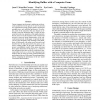Free Online Productivity Tools
i2Speak
i2Symbol
i2OCR
iTex2Img
iWeb2Print
iWeb2Shot
i2Type
iPdf2Split
iPdf2Merge
i2Bopomofo
i2Arabic
i2Style
i2Image
i2PDF
iLatex2Rtf
Sci2ools
AAAI
2012
2012
Identifying Bullies with a Computer Game
Current computer involvement in adolescent social networks (youth between the ages of 11 and 17) provides new opportunities to study group dynamics, interactions amongst peers, and individual preferences. Nevertheless, most of the research in this area focuses on efficiently retrieving information that is explicit in large social networks (e.g., properties of the graph structure), but not on how to use the dynamics of the virtual social network to discover latent characteristics of the realworld social network. In this paper, we present the analysis of a game designed to take advantage of the familiarity of adolescents with online social networks, and describe how the data generated by the game can be used to identify bullies in 5th grade classrooms. We present a probabilistic model of the game and using the in-game interactions of the players (i.e., content of chat messages) infer their social role within their classroom (either a bully or non-bully). The evaluation of our model is ...
AAAI 2012 | Computer Involvement | Intelligent Agents | Online Social Networks | Psychological Surveys |
| Added | 29 Sep 2012 |
| Updated | 29 Sep 2012 |
| Type | Journal |
| Year | 2012 |
| Where | AAAI |
| Authors | Juan Fernando Mancilla-Caceres, Wen Pu, Eyal Amir, Dorothy Espelage |
Comments (0)

